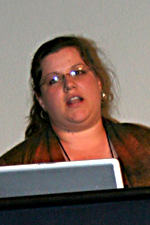Technical Keynote Session 2
Docility’s Effect on Economically Relevant Traits

Janice Rumph, Michigan State University
Docile cattle have higher average daily gains (ADGs), better carcass characteristics and offer more profit in the feedlot, but little is known about docility’s correlation across time to other traits of interest to producers. To learn more, Michigan State University (MSU) launched two multi-year projects, and Janice Rumph shared the preliminary results of the first year of data collection at the 2009 Beef Improvement Federation (BIF) Conference May 1 in Sacramento, Calif.
The first project included 23 Limousin x Angus F2 calves born in fall 2008. Docility and exit velocity, a potential indicator of docility, were individually measured at weaning, prior to transport to the feedlot (44 days postweaning) and upon arrival at the feedlot.
“In general, weight and height traits were lowly correlated with docility scores and exit velocities, but showed the highest correlations with pre-transport exit velocity, indicating that taller, heavier animals tended to exit the chute faster than their smaller contemporaries,” Rumph said. “Birth weight showed a positive and moderate correlation between post-transport docility score and birth weight, although this may be a function of the small data set.
“Interestingly, shrink showed negative correlations with docility scores measured at weaning and post-transport, indicating that animals that were perceived as more hyperactive lost less weight in transport than more docile animals,” she continued.
The second project involved 108 bulls entered in the Michigan Cattlemen’s Association/MSU Bull Performance Test. The majority of the bulls consigned to the test were Angus or Simmental, with only seven being from other breeds. They were measured for docility score and exit velocity at 28-day intervals throughout the 112-day test.
“Increased docility score (a more anxious animal) was correlated with lower weaning weights, greater average daily gain, greater ultrasound ribeye area (REA), more ultrasound intramuscular fat (IMF), more ultrasound backfat and a lower sale price,” Rumph said.
“In general, the fat measurements in Angus tended to be more highly correlated with docility and exit velocity than in Simmental bulls,” she said, “indicating that fatter Angus animals were more excitable and exited the chute and salering faster than their leaner contemporaries.”
Another trend was that bulls with faster exit velocities were more likely to fail their breeding soundness exam (sometimes called a BSE) and be disqualified from the sale, though the correlation was low. Another lowly correlated trend was that more docile Angus bulls received higher sale prices while more docile Simmental bulls received lower sale prices.
Both the weaned calf project and the yearling bull project will continue gathering data for several more years.
Editor’s Note:This summary was written under contract or by staff of Angus Productions Inc. (API). To request reprint rights contact Shauna Rose Hermel, editor, at 816-383-5270. PowerPoints are posted with permission of the presenter and may not be reproduced in whole or in part without the express permission of the presenter.
The 41st BIF Research Symposium and Annual Meeting was hosted by the California Beef Cattle Improvement Association and the California Cattlemen's Association. For more information, visit www.bifconference.com or www.calcattlemen.org/bif2009.html.



